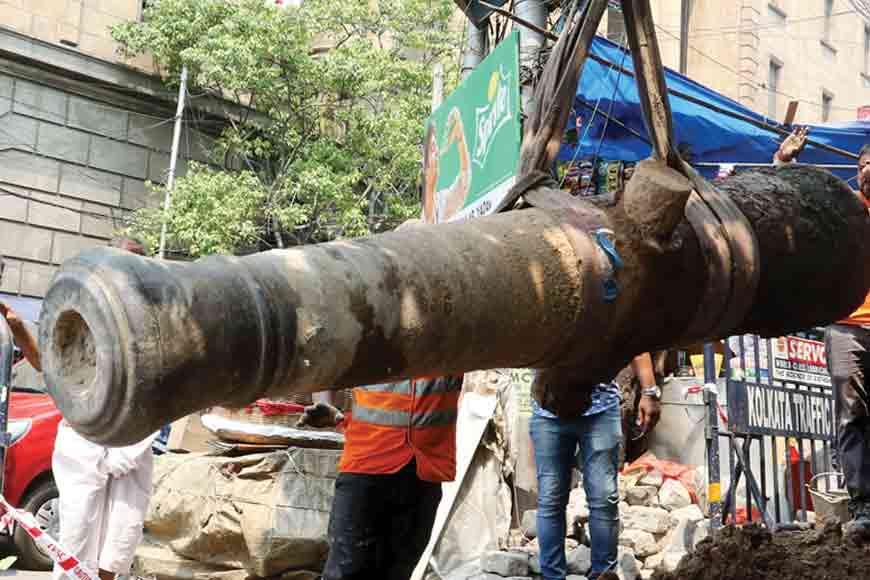British-era cannon pulled out from a busy pavement in Kolkata!

Last week Strand Road of Kolkata looked like a page right out of a history book as a huge hydraulic crane successfully pulled out a “British-era cannon” on the ground and lifted it to a safe place where now it will find its glory back. But the question automatically arises what are old-world cannons doing on the streets of a bustling modern metropolis and that too in the 21st century where nuclear weapons have replaced wartime cannons as weapons of mass destruction?
To be precise, as the erstwhile capital of British India, Kolkata and Bengal since ages had been home to different types of cannons – be they from the last independent Nawab Sirajaudullah’s time, cannons that the British seized when they defeated the Nawab, or the ones that they got when Siraj invaded the British or even World War II cannons. The one that was pulled out last Wednesday, was dug deep, around 9ft below the pavement surface at the Fairlie Place-Strand Road intersection. For ages, passers-by would admire two such cannons sticking their heads out on busy pavements of the ‘office para’ of Kolkata, some even took no notice, and some did not know the history.
But digging the cannons out was no mean feat as they were enmeshed in power cables and high-tension wires that had been laid below for years. So to take it out successfully, a weight-bearing strap was wrapped around the muzzle of the cannon, which in turn was connected to a hydraulic crane. The crane took around 15 minutes to pull out the 10-foot-long cannon, which weighs more than 2,000kg. And as the cannon was being pulled out, a stone’s throw from the headquarters of Eastern Railways at Fairlie Place, a huge crowd gathered around to witness the historic moment. Traffic personnel had a difficult time keeping the crowd off bars as they were busy posing with the cannon to take selfies. The cannon was taken to the New Secretariat building, around 1km away, where it will be restored.
Once the restoration is complete, the cannon will be kept at New Secretariat, where it will join the 10.5ft-long, 31-pounder cannon manufactured in 1796. It was excavated from near the Dum Dum Central jail. The markings on that revealed that the gun dug out from near the jail was a Blomfield cannon, named after its designer Thomas Blomfield, who was the inspector of artillery and superintendent at the Royal Brass Foundry in Britain.
In March, Kolkata witnessed a display of cannons and arms of the Nawab era and also those from World War II. This newly excavated cannon will be part of that huge cache of antique arms that Bengal’s various museums are proud to house. Biplab Roy, administrator general and official trustee of Bengal, who was supervising the dig, told the media: “A team of experts led by me and Amitabha Karkun, a war history and firearm enthusiast, and some labourers will clean the cannon with soft brushes. The next step will be to remove the dirt using a chemical solution from the sections where the date and place of manufacture and the name of the manufacturer are generally engraved.”
Usually, such cannons have markings engraved at three places. The date, the place of manufacture, and the name of the manufacturer are usually found.“ These markings are generally engraved near the firing hole at the rear of the cannon. Some have markings and engravings along the barrel for a few inches. We need to remove the coat of mud and soil before we can get to those markings,” said Karkun. Once these markings are recovered and the date of manufacture is ascertained and recorded, the team will start the restoration process which will take around 20-25 days.
However, experts from the first sight of the cannon believe it to be a British-era 24-pounder cannon. Its bore though is much wider than a standard 24. That might be because someone sometime had tried to see off the portion that was sticking out of the pavement and steal it away. Such cannons could fire shots weighing 24 pounds at a distance ranging from 700 to 1,200 yards depending on the amount of gunpowder used and the elevation of the barrel. These guns were considered to be heavy artillery pieces that had a better range compared with other cannons of those times.
To be precise, as the erstwhile capital of British India, Kolkata and Bengal since ages had been home to different types of cannons – be they from the last independent Nawab Sirajaudullah’s time, cannons that the British seized when they defeated the Nawab, or the ones that they got when Siraj invaded the British or even World War II cannons. The one that was pulled out last Wednesday, was dug deep, around 9ft below the pavement surface at the Fairlie Place-Strand Road intersection
During the inspection, the team ascertained the bore to be around 6.45 inches. Although the exterior of the cannon was caked in mud, it seems to be in good shape. An initial inspection revealed it has not rusted, which indeed reflects how advanced science was in those days. The team also found under the pavement a concrete plate, into which at least 10 inches of the cannon had been sunk to make it stand vertically. Roy told the media:
“Since this was mounted, we are quite sure that it had been propped up as a sentinel piece. Since this area is quite close to Fort William, it is not unlikely that it had been mounted as a war history monument or a sentinel piece.”
Once the restoration is complete, the cannon will be kept at New Secretariat, where it will join the 10.5ft-long, 31-pounder cannon manufactured in 1796. It was excavated from near the Dum Dum Central jail. The markings on that revealed that the gun dug out from near the jail was a Blomfield cannon, named after its designer Thomas Blomfield, who was the inspector of artillery and superintendent at the Royal Brass Foundry in Britain. The same team has restored five more cannons, which are all kept in the office of the administrator general and official trustee of Bengal at the New Secretariat. One of them is of Dutch origin and was found in Chinsurah. Hence the latest cannon will now find a place from the pavement to a place of glory.











